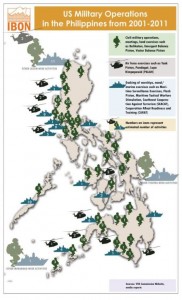This post is part of our International Relations & Security coverage.
A maritime dispute with China has forced the Philippines to review its defense capabilities. Tension arose earlier this year when Beijing and Manila accused each other of illegally occupying the territorial waters near the Scarborough Shoal located in the South China Sea.
The government has already dispatched several diplomatic missions seeking military agreements or cooperation with various countries in the Asia-Pacific.
The weak defense system of the Philippines is no secret. Even President Benigno Aquino joked about this during his recent state of the nation address:
Some have described our Air Force as all air and no force. Lacking the proper equipment, our troops remain vulnerable even as they are expected to be put in harm’s way. We cannot allow things to remain this way. We will no longer send paper boats out to sea. Now, our 36,000 kilometers of coastline will be patrolled by more modern ships.
Aquino also assured Filipinos that the government is prepared to modernize its defense forces:
Before this year ends, we are hopeful that the twenty-one refurbished UH-1H Helicopters, the four combat utility helicopters, the radios and other communication equipment, the rifles, the mortars, the mobile diagnostic laboratories, and even the station bullet assemblies we have purchased will be delivered. Come 2013, ten attack helicopters, two naval helicopters, two light aircraft, one frigate, and air force protection equipment will also be arriving.
But he clarified that the procurement of new war machines is not intended to provoke hostilities:
We are not doing this because we want to be an aggressor, we are not doing this because we want escalation. This is about keeping the peace. This is about protecting ourselves—something that we have long thought impossible.
Last year, the Philippines acquired an old Coast Guard Cutter from the United States which now patrols the western coastal areas of the country. The Philippines and the United States (U.S.) have a Mutual Defense Pact which was signed in the 1950s. Below is a video uploaded by YouTube user PHMalaya of the turnover of the ship from the U.S. to the Philippines:
Aside from navy ships, the Philippines is also planning to buy F-16 jets since the country has no attack aircrafts as of the moment.
But the Philippines, it seems, is also looking to establish military ties with other countries. It has recently decided to purchase military equipment from European countries. It seeks to acquire two frigates from Italy equipped with modern anti-ship and anti-aircraft missile systems. It also recently finalized a deal with Japan which “will cover military exchanges between the two armed forces, naval visits, meetings related to internal and external security issues, defense technology and knowledge exchange, issues related to maritime security, and information exchange.”
The Senate has also ratified the Status of Visiting Forces Agreement between the Philippines and Australia “for the purposes of conducting military education, training, and exercise, humanitarian activities.” But Senator Joker Arroyo opposed the agreement claiming that it was drafted to send a message to China:
The Aquino administration only wants this ratified because of the country’s dispute with China over the West Philippine Sea. Although the agreement is not a defense pact, its symbolism cannot be lost on China. Let us not grab at straws. We must persevere.
It’s no coincidence that military exercises between the Philippines and the U.S. became more frequent in the past year. This was a time when the Philippine-China maritime standoff intensified. Writer Erick San Juan questions the relevance of these military exercises:
We cannot help but ask ourselves – do we really need such annual exercises? We have several of the same kind already and recently they are not being useful to us and to the rest of the Asia-Pacific region. Obviously, it is a tool for provocation whether we like it or not. Any accidental firing or miscalculations during such exercises, could be use as pretext for regional conflict. As a sovereign nation, we have to assert our rights to our territory and if we do not have the military might, peaceful diplomatic solution is always the best answer.
Activist Arnold Padilla shares a similar view:
China’s assertive stance in its dispute with the country over the Scarborough Shoal and the Spratly Islands is being used to justify increased US military presence and intervention in the Philippines and in the region. While this serves US’s agenda in Asia Pacific, it also raises further risks to peace and development in the region and to the national sovereignty of the Philippines.
 This post and its translations to Spanish, Arabic and French were commissioned by the International Security Network (ISN) as part of a partnership to seek out citizen voices on international relations and security issues worldwide. This post was first published on the ISN blog, see similar stories here.
This post and its translations to Spanish, Arabic and French were commissioned by the International Security Network (ISN) as part of a partnership to seek out citizen voices on international relations and security issues worldwide. This post was first published on the ISN blog, see similar stories here.







2 comments
The weapons business industry made it again. The US will export the arms, mostly made in China, to the Philippines. Wag the dog, then outsource the conflict. Nice, very nice!
I should say that the Philippines is facing a credible threat from China and it’s allies. China’s news have warned the Philippines of possible conflict and war. The Philippines should prepare for strong contingency’s to defend it’s country sovereignty if war erupts with China.